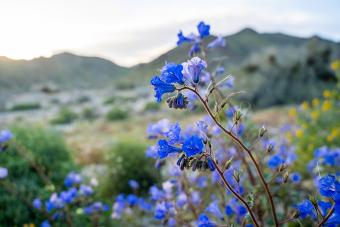
Phacelia is a group of sun-loving annuals with showy flowers, mainly from the western states of North America. Some are only a few inches high and spread along the ground while others are several feet in height, bearing bell-shaped or tubular flowers in shades of blue, purple, mauve, or white. While they aren't very common garden plants, you might want to consider growing phacelia if you have sandy or dry soil.
How to Plant Phacelia
Phacelia blooms about ten weeks after sowing. It's best to sow them directly into their spot in the garden, sowing after your last spring frost date, since phacelia doesn't like to have its roots disturbed. The tall varieties should be planted fairly close, and the trailers farther apart to give them room to sprawl.

Phacelia seeds need darkness to germinate, so make sure the seeds are planted about a quarter of an inch deep. It's best to plant them as soon as the soil can be worked, since they germinate best in cool soil.
You can also grow them by planting transplants, but since this isn't a very common garden plant, your best bet for growing phacelia will be to sow seeds.
Plant in a spot with sandy or even poor soil (just not anywhere that stays wet for extended periods of time) and in full sun.
How to Grow Phacelia
Phacelia are generally grown as annuals, and, once they've germinated and are growing well, they need very little maintenance. After the first few weeks, they'll only need to be watered during extended dry spells. They don't require additional fertilization, though you can always add a side dressing of compost either at planting time or when they're getting ready to bloom.
Phacelia Pests and Diseases
Phacelia doesn't really have any pest or disease problems. In fact, the only problem you might run into is that, if it's in a spot where it thrives, it might grow too well. Phacelia can become invasive if the flower heads are left on the plant, since it reseeds readily.
Pruning Phacelia
To prevent it from reseeding all over your garden, you'll want to prune off the flower heads of phacelia once it's finished blooming. Some gardeners grow phacelia as a green manure, and if you decide to do the same, you'll want to dig the plants under before it blooms.
Varieties of Phacelia to Grow in Your Garden
While there are several varieties of phacelia, only one or two are commonly grown in home gardens, the most common being lacy phacelia, California bluebells, and trailing phacelia. However, since these are wildflowers, you might come across some of the other varieties if you live or travel in the southwestern United States.
Lacy Phacelia (Phacelia tanacetifolia)
Lacy phacelia is the most commonly planted variety of phacelia for home gardens. The clover-like flowers bloom in shades of pink and purple, and they're highly attractive to butterflies and bees. Lacy phacelia grows one to three feet tall and makes both a pretty garden plant and a wonderful cut flower for arrangements.

California Bluebells (Phacelia campanularia)
This variety of phacelia has dark blue flowers, spotted with white in the throat. The flowers last a long while, and the plant makes a pretty carpet in sunny places. This cool season annual, native to California, is another popular choice for home gardeners due to its vibrant blue flowers and how easy it is to grow. It looks wonderful planted in drifts at the edges of garden beds.

Trailing Phacelia (Phacelia divaricata)
Another California native, trailing phacelia has one-inch lavender blooms with white centers. The plants grow to about 10 inches tall and 12 to 16 inches across and produce abundant blooms through most of the summer. This is a good option for garden beds, containers, and hanging baskets.

Eric in SF, CC BY-SA 3.0, via Wikimedia Commons wikimedia commons Phacelia divaricata
Fernleaf Phacelia (Phacelia bipinnatifida)
Fernleaf phacelia is a bushy plant of one to two feet tall with dissected leaves that are covered with downy hairs. The flowers, which open in succession from July to September, are small but very numerous, and arranged similar to those of heliotrope. The buds are white and the open flowers are bright blue with prominent stamens. This is actually another variety that's pretty as a cut flower, and unlike most, this is found farther east and as far north as Ohio.

Ed Reschke/ Stone Getty Images
Douglas Phacelia (Phacelia Douglasii)
Phacelia douglasii is a neat spreading plant with the habit and appearance of Nemophila insignis, its hairy and deeply-cut leaves gathered near the base of the stems, and the bell-shaped blue flowers measuring about half an inch across.

Genevieve K. Walden, CC BY-SA 3.0, via Wikimedia Commons wikimedia commons Phacelia douglasii
What to Plant With Phacelia
Phacelia is wonderful to plant with other cool-season annuals, though it's worth keeping in mind that once they've finished blooming, you might want to have something else ready to fill any empty spots in the garden. Consider planting phacelia with:
- Calendula
- Foxglove
- Snapdragon
- Nigella
- Bells of Ireland
A Beautiful North American Native Plant
If you want to incorporate more native plants in your garden, consider one of the many varieties of phacelia. Easy to grow, attractive to pollinators, and pretty as both a garden flower and in flower arrangements, this is definitely a plant worth growing. Just keep in mind that it can reseed pretty easily, so you'll have to keep up with deadheading the flowers unless you want to find phacelia growing everywhere the following year.







